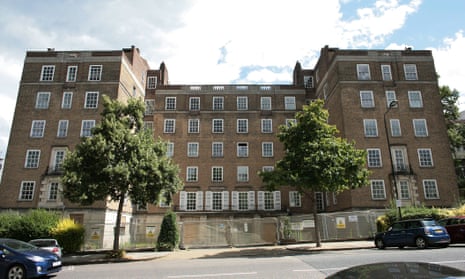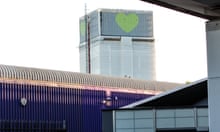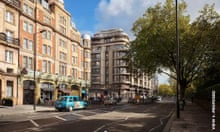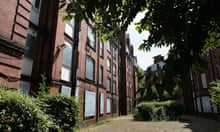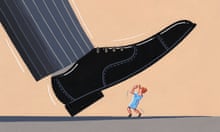A string of oligarchs, foreign royalty and multimillionaire businesspeople have been revealed as the owners of vacant properties in the borough where the deadly Grenfell Tower fire left scores of people homeless.
Owners of the 1,652 properties listed as unoccupied by Kensington and Chelsea council include a Ukrainian billionaire fighting extradition to the US, a former mayor of New York, a high-profile luxury property developer and a senior television executive.
They include the distinctive former Brompton Road tube station building, once used as a top secret command centre for Winston Churchill, but which has been vacant since it was bought for £53m by the Ukrainian oligarch Dmytro Firtash in 2014.
The list of owners of vacant properties includes the former New York mayor Michael Bloomberg, who bought a seven-bedroom grade II*-listed mansion for £16m in 2015. Once home to the writer George Eliot, it boasts a baroque ceiling mural of Venus by James Thornhill, who painted the interior of the dome of St Paul’s Cathedral.

The names were revealed in a list that appears to have been accidentally sent by the council to multiple recipients, including the Guardian, and details the council tax information of the vacant homes and their 1,197 owners.
More than a third of the vacant homes (603) are recorded as having been empty for more than two years, with the owners paying a 50% premium on their council tax. A further 1,010 are classified as unoccupied and substantially unfurnished, while the other 39 have been unoccupied for less than a year, with building work in progress.
Some of the luxury properties identified as long-term empty are just a few hundred metres from the charred remains of Grenfell Tower, where at least 80 people died in June. Of the survivors only 12 households have been re-accommodated, with dozens still in temporary housing.
Other unoccupied properties are owned by offshore companies, including Dukes Lodge London Ltd, part of Christian Candy’s luxury property business, which is listed as owning 26 homes in a 1930s mansion block valued at £85m in 2015; and Smech Properties Ltd, owned by Sheikh Mohammed bin Rashid Al Maktoum, the vice-president of the United Arab Emirates and ruler of Dubai.

CPC London, a subsidiary of Candy’s property business, said Duke’s Lodge was undergoing major refurbishment and was “currently unsafe and uninhabitable for use”. The developer plans to demolish the existing seven-storey mansion block in Holland Park and replace it with five interlinked villas, including a two-floor basement and underground parking, although this has yet to be approved by the council’s planning department.
A company spokesman said the building “has been entirely stripped back to a base shell in preparation for imminent demolition”, which included removing “all the mechanical and electrical equipment, the lifts, flooring, ceilings etc”. He said the company was awaiting approval by the council for “the final pre-demolition planning condition”.

In another case, plans to develop a property had been delayed. A lawyer for Firtash confirmed he had bought a £53m property in the area in May 2014, which he intended to develop into multiple flats. But the work had been unable to proceed because the oligarch was detained in Vienna on a US extradition warrant. The lawyer said his client intended to proceed with the development once he was free and able to travel to the UK.
Bloomberg did not respond to a request for comment. At his property, the front garden wall was covered with wooden hoarding bearing a development company’s name, and scaffolding covered the facade of the building itself.

Peter Fincham, the former director of ITV television and controller of BBC1, said a £6m property he owns was in the process of being transferred to a new owner. “We contracted to sell this property in December 2016 and are awaiting completion,” he said in a statement.

The gates of the cream and white fronted home, purchased in May 2015, were covered in hoarding when visited by a reporter. Behind the boards, the front garden was full of tall weeds and piled with fallen leaves and plastic bags.
Some of the information in the council’s records appeared to be wrong. A flat belonging to the government of Brunei was listed as having been empty for more than two years. A representative of the high commission said it had been inhabited by staff since its purchase more than three years ago. In another instance, the head of a major bank who was identified as the owner of an empty property answered the door when it was visited by a reporter.
Cllr Kim Taylor-Smith, the deputy leader of Kensington and Chelsea council, said: “If a property has been left unoccupied and unfurnished for two years or more, property owners will be charged an additional 50% of the full council tax charge. Unfortunately, we have no powers to compel owners to live in their properties, but we can and do offer support and advice to help bring long-term empty properties back into use.”
Guy Shrubsole, of the campaign group Who Owns England, which advocates for greater transparency in the housing market, said: “Who owns land and property remains one of the UK’s oldest secrets, and this disclosure shines a light on the need for wholesale reform of Britain’s broken housing market, including increased transparency on ownership.
“There is a clear public interest in better understanding the issue of empty homes in London’s over-heated property market, why they are being bought and left empty, and where the money is coming from.”
An additional council tax payment, worth 50% of the normal rate, is levied on homes left empty for more than two years. But for most properties this amounts to an extra few hundred pounds a year, and no more than £1,500, according to the council data, despite some of the properties being worth tens of millions of pounds.
Anna Powell-Smith, of Who Owns England, who analysed the data, said: “This is about our broken housing system. Many of these people are leaving their homes empty because they don’t need the rent, and in that situation we could reasonably ask them to contribute more. But we can only have a proper debate about fair levels of council tax with full transparent data on ownership and housing use.”
The day after the Grenfell disaster, Jeremy Corbyn called for homes left vacant by rich overseas investors in Kensington and Chelsea to be “requisitioned” for survivors. The Labour leader described the borough as “a tale of two cities”, with great wealth in the south and pockets of severe poverty in the north.

There are 64 homes listed as vacant in Notting Dale, the ward where Grenfell Tower stood. Of those, six are recorded as having been vacant for more than two years, and the remainder fall in the category of unoccupied and substantially unfurnished.
The ward listed as having the highest number of long-term empty properties is Brompton and Hans Town, the area around Sloane Street, whose local councillors include the former council leader Nicholas Paget-Brown, who resigned after the Grenfell disaster. The ward has 100 homes listed as empty for more than two years and another 128 recorded as unoccupied and substantially unfurnished.
To date, Kensington and Chelsea has made 169 offers of accommodation to the survivors of Grenfell, 46 of which have been accepted. Only twelve households have been rehoused.
Taylor-Smith added in his statement: “We are committed to helping the victims of the Grenfell Tower fire, and Kensington and Chelsea council has secured 105 flats so far, including 68 at Kensington Row and 31 on Hortensia Road – we are currently in the process of allocating the properties.
“In addition, we are committed to building or buying 400 social housing units over the next five years and we are working with central government to secure a deal for north Kensington which will allow us the freedom to borrow against the housing revenue account and have more flexibility in how to use money from right-to-buy sales.”
